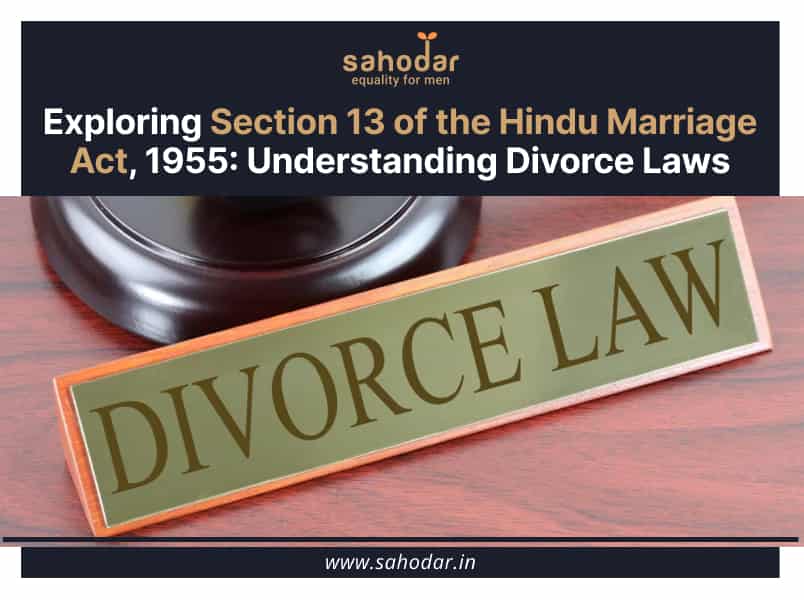Marriage, being the foundation of family and society, is considered sacrosanct in Hindu culture. However, despite the sanctity attached to it, marriages can sometimes encounter irreconcilable differences, leading to the dissolution of the marital bond. The Hindu Marriage Act, 1955, enacted to regulate Hindu marriages and provide legal remedies in matters concerning marriage, encompasses various provisions for divorce, with Section 13 being pivotal in this regard. This article delves into the intricacies of Section 13 of the Hindu Marriage Act, 1955, shedding light on its provisions, grounds for divorce, procedural aspects, and the broader implications of divorce within the Hindu legal framework.
Historical Context and Legislative Intent
The Hindu Marriage Act, 1955, was enacted to codify the laws relating to marriage and divorce among Hindus, encompassing persons professing the Hindu, Buddhist, Jain, or Sikh religions. Prior to the enactment of this legislation, Hindu marriages were governed by customary laws and religious practices, leading to inconsistencies and inadequacies in legal provisions. The Hindu Marriage Act aimed to provide a uniform legal framework for the solemnization and dissolution of Hindu marriages, thereby ensuring clarity, consistency, and legal protection for individuals entering into marital unions.
Overview of Section 13
Section 13 of the Hindu Marriage Act, 1955, delineates the grounds upon which either party to a Hindu marriage may seek divorce. The section categorizes these grounds into two main categories: fault-based grounds and no-fault grounds.
Fault-based Grounds
- Adultery: Adultery refers to voluntary sexual intercourse between a married person and someone who is not their spouse. Adultery is considered a grave breach of marital trust and fidelity, constituting grounds for divorce under Section 13(1)(i) of the Act.
- Cruelty: Cruelty, whether mental or physical, forms another ground for seeking divorce under Section 13(1)(ia). Cruelty may manifest in various forms, including verbal abuse, physical violence, emotional manipulation, or neglect. The courts consider the impact of cruelty on the mental and physical well-being of the aggrieved spouse while adjudicating divorce cases.
- Desertion: Desertion entails the intentional abandonment of one spouse by the other without any reasonable cause or justification. To constitute desertion under Section 13(1)(ib), there must be a clear intention to bring cohabitation to an end, along with an absence of consent from the deserted spouse.
- Conversion to Another Religion: Section 13(1)(ii) provides for divorce on the ground of conversion to another religion. If either party to the marriage converts to another religion, thereby ceasing to be a Hindu, the other party may seek divorce on this ground.
- Unsoundness of Mind: Section 13(1)(iii) allows for divorce on the ground of unsoundness of mind. If either party to the marriage is of unsound mind or suffers from a mental disorder of such a nature that it renders them unfit for marriage and the procreation of children, the other party may seek divorce.
- Leprosy: Section 13(1)(iv) permits divorce on the ground of the spouse suffering from a virulent and incurable form of leprosy. Leprosy, being a contagious and debilitating disease, is considered a valid ground for seeking dissolution of marriage under this provision.
No-Fault Ground
- Irretrievable Breakdown of Marriage: Section 13(1A) introduced by an amendment in 1976 provides for a no-fault ground for divorce, commonly known as irretrievable breakdown of marriage. This provision allows either party to seek divorce by mutual consent if they have been living separately for a period of one year or more, and there is no possibility of reconciliation. Irretrievable breakdown of marriage reflects the recognition that sometimes, despite best efforts, marriages reach a point of irreconcilable differences, making it untenable for the parties to continue cohabitation.
Procedure for Divorce
The procedure for seeking divorce under Section 13 involves several steps, including filing a petition before the appropriate family court or district court, depending on the jurisdiction. The petitioner must provide evidence supporting their claim for divorce based on one or more of the grounds specified under Section 13. The court may also facilitate mediation or counseling sessions to explore the possibility of reconciliation between the parties before granting divorce.
Impact of Divorce
While divorce provides an avenue for individuals trapped in unhappy or dysfunctional marriages to seek liberation and move forward with their lives, it also entails significant emotional, social, and financial consequences. Divorce often brings about changes in familial dynamics, especially concerning children, custody arrangements, and financial settlements. Moreover, the stigma associated with divorce in traditional Hindu society can pose challenges for divorced individuals, particularly women, in terms of societal acceptance and reintegration.
Conclusion
Section 13 of the Hindu Marriage Act, 1955, embodies the legal framework governing divorce in Hindu marriages, providing a recourse for individuals facing irreconcilable differences or suffering from marital distress to seek dissolution of their marriage through legal means. However, divorce should be viewed as a last resort, and efforts towards reconciliation and mediation should be explored wherever possible to preserve the sanctity of marriage and mitigate its adverse effects on the parties involved. By understanding the provisions of Section 13 and the broader implications of divorce, stakeholders can navigate the complexities of marital disputes with greater clarity and sensitivity, fostering amicable resolutions and promoting the welfare of all individuals affected by marital breakdowns.

